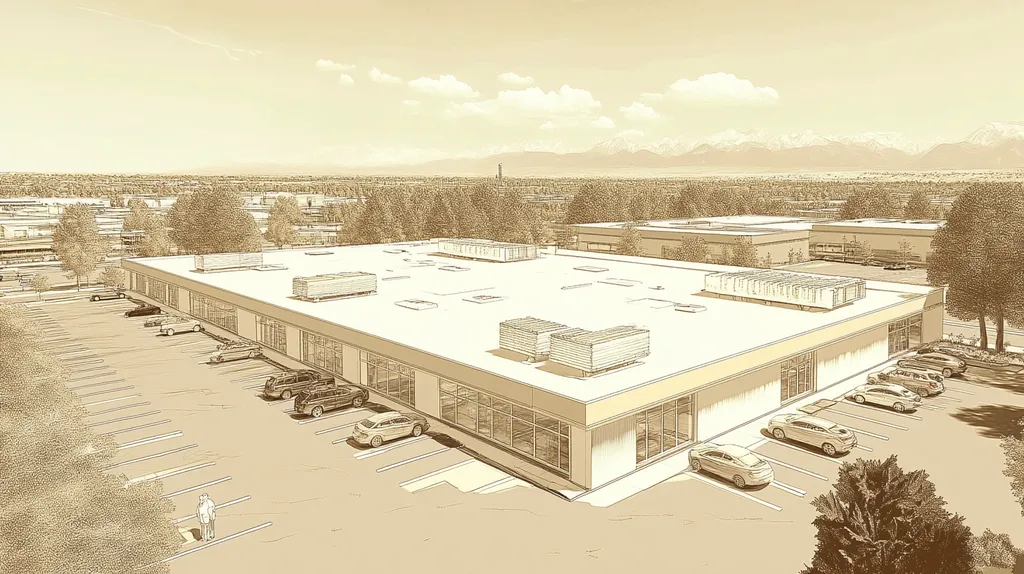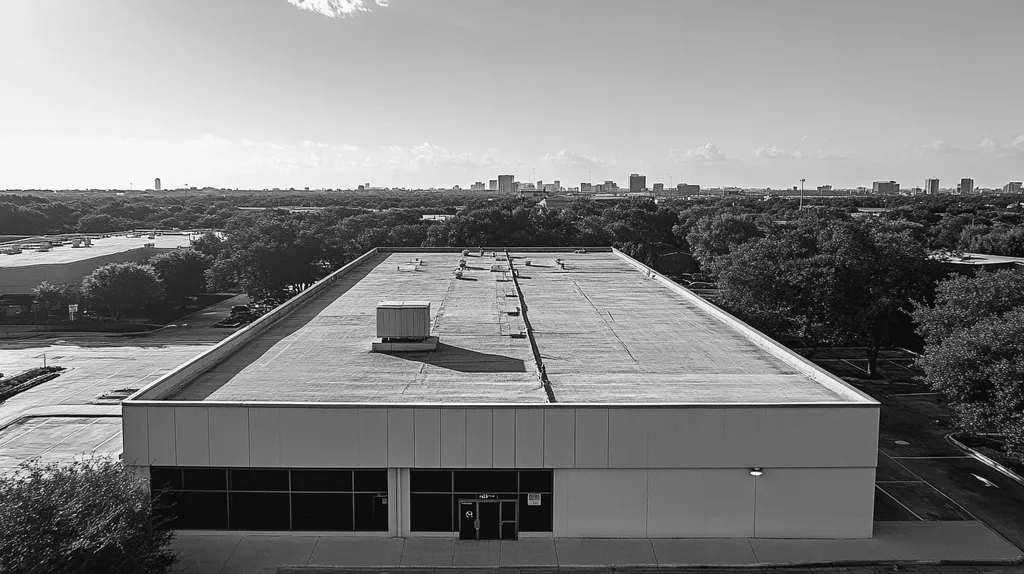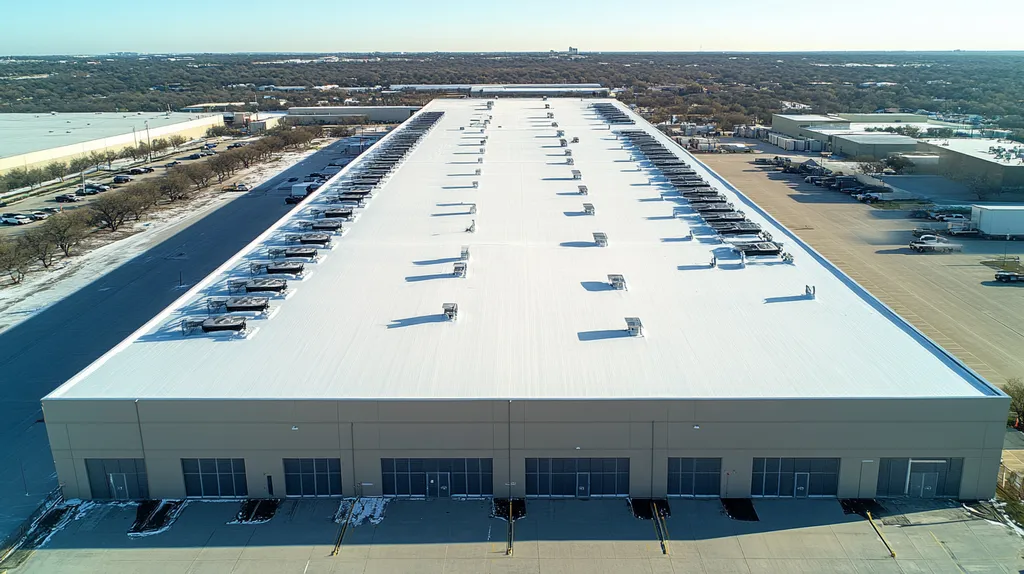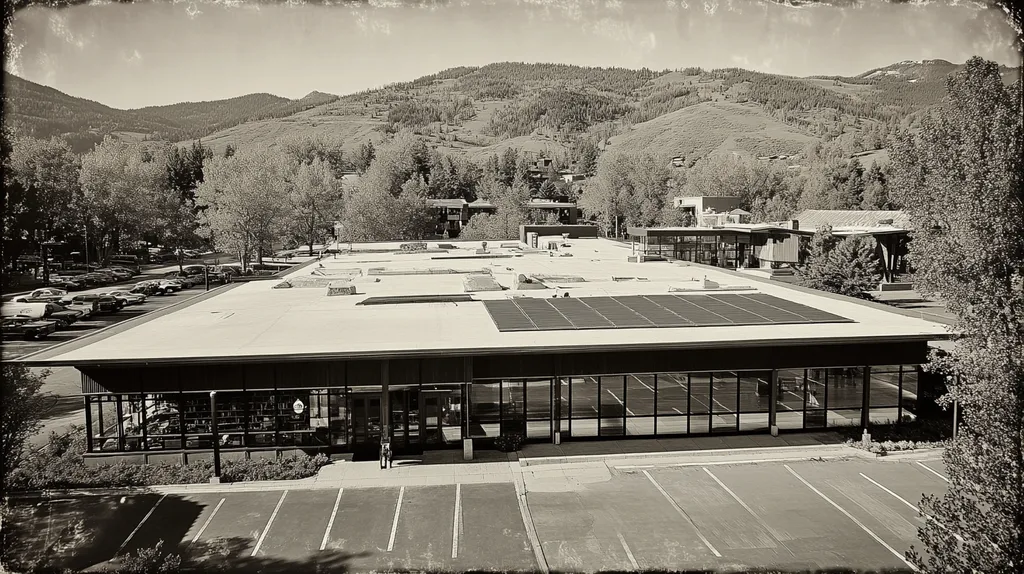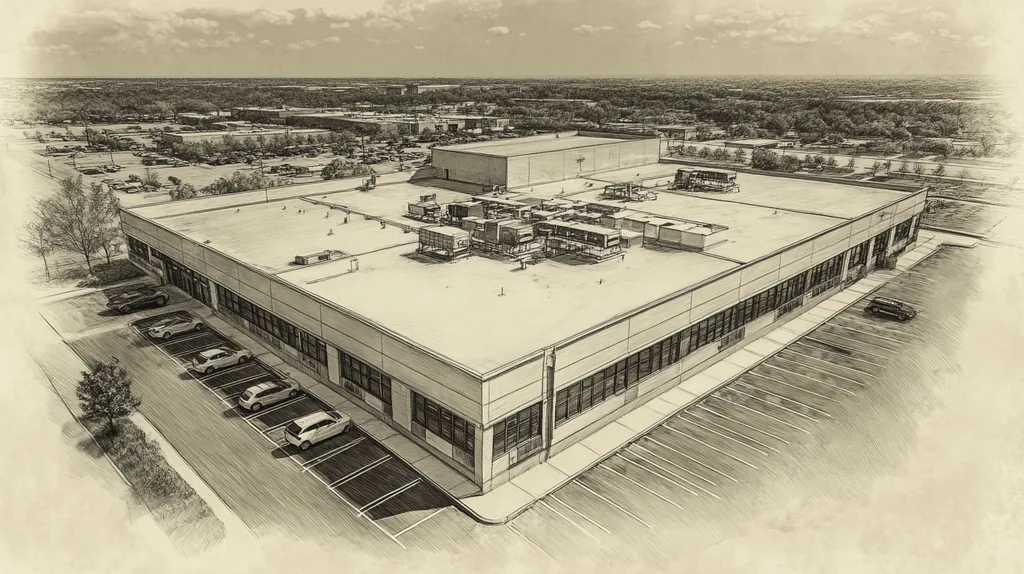The $50 billion commercial roofing industry faces a crisis that threatens to slash roof lifespans by up to 40% through misguided cleaning practices. Each year, aggressive maintenance methods damage millions of square feet of high-performance membranes while property owners remain unaware of the destruction occurring overhead.
From harsh pressure washing that creates microscopic tears to caustic cleaning agents that accelerate material breakdown, traditional approaches are creating a ticking time bomb of premature failures. This systematic examination exposes the hidden costs of current practices while highlighting emerging alternatives that promise superior results at lower lifetime costs.
SECTION 1: CURRENT PRACTICES
In the high-stakes world of commercial roofing, where a single cleaning mistake can trigger hundreds of thousands in damage, many facility managers still cling to outdated maintenance practices. The $50 billion commercial roofing industry continues to push aggressive cleaning methods that promise quick results but often deliver long-term headaches. From questionable pressure washing techniques to harsh chemical cocktails that would make a hazmat team nervous, current practices need serious reconsideration.
Industry Standard Cleaning Protocols
Today’s standard protocols read like a greatest hits album of questionable choices. Most focus on rapid turnaround and minimal labor costs, prioritizing speed over substance.
These one-size-fits-all approaches ignore crucial variables like membrane type, coating age, and environmental conditions. It’s the equivalent of prescribing the same medicine for every ailment.
The National Park Service emphasizes using the “gentlest means possible” when cleaning building surfaces, avoiding harsh acidic or alkaline products that can compromise material integrity. (source: National Park Service)
Most concerning is the industry’s resistance to adopting gentler, more effective cleaning methods that might require initial investment but deliver superior long-term results.
Common Use of Pressure Washing Equipment
The commercial roofing sector’s love affair with pressure washers continues unabated. These machines, capable of stripping paint from concrete, are regularly unleashed on delicate roof membranes and coatings.
While pressure washing equipment manufacturers tout adjustable PSI settings as a safety feature, field observations reveal most operators default to maximum pressure. It’s like using a fire hose to water houseplants.
The immediate visual results mask underlying damage. Microscopic tears, coating erosion, and compromised seams often don’t manifest until months later – conveniently after warranty periods expire.
Despite mounting evidence of pressure washing’s destructive potential, its use persists largely due to speed and familiarity rather than effectiveness.
Reliance on Conventional Chemical Agents
The chemical cleaners commonly used in commercial roof maintenance read like a dystopian chemistry exam. These industrial-strength solutions promise to obliterate everything from algae to zebra stripes.
What’s rarely discussed is their cumulative effect on roofing materials. Many conventional cleaners gradually weaken membrane plasticizers, accelerate coating breakdown, and create surface micro-abrasions that become failure points.
Environmental concerns extend beyond the roof itself. Chemical runoff affects landscaping, stormwater systems, and local wildlife. Some facilities have faced EPA scrutiny over their cleaning practices.
The industry’s continued reliance on these aggressive solutions reflects a broader pattern of prioritizing immediate results over sustainable performance.
SECTION 2: SYSTEMIC ISSUES
In the $50 billion commercial roofing industry, systemic flaws in cleaning practices threaten to undermine billions in property investments. While traditional methods promise quick results, they’re creating a ticking time bomb of compromised membranes, inconsistent outcomes, and environmental hazards. These issues aren’t just theoretical – they’re driving up insurance premiums, voiding warranties, and attracting regulatory scrutiny across North America.
Hidden Damage Risks to Roof Membranes
Every aggressive cleaning session leaves microscopic battle scars on roof membranes that compound over time. What looks pristine to the naked eye often reveals a horror show under magnification – countless micro-tears and surface abrasions that become failure points.
The damage typically manifests in stages, starting with barely detectable coating erosion. Within months, these compromised areas can develop into blisters, delamination, and membrane separation – conveniently after most cleaning warranties expire.
The National Park Service advocates for using the “gentlest means possible” when cleaning building surfaces, warning against harsh cleaning products that can compromise material integrity. (source: National Park Service)
Most concerning is how this hidden damage creates perfect conditions for moisture infiltration. Water finds these microscopic entry points and begins its destructive work, often going unnoticed until major problems emerge.
Inconsistent Results Across Roofing Materials
The commercial roofing sector’s one-size-fits-all cleaning approach ignores fundamental material differences. What works for a TPO membrane can devastate an EPDM surface, while cleaning methods safe for modified bitumen might wreak havoc on PVC.
These material-specific vulnerabilities create a cleaning roulette where success depends more on luck than science. Some surfaces emerge unscathed while others suffer irreversible damage from identical treatment.
The problem extends beyond immediate cleaning results to long-term performance. Different materials age and weather uniquely, making standardized cleaning protocols about as effective as using the same prescription for every medical condition.
Warranty implications add another layer of complexity. Many manufacturers now explicitly exclude damage from aggressive cleaning methods, leaving building owners exposed to substantial replacement costs.
Underestimated Environmental Contamination
The environmental impact of conventional roof cleaning extends far beyond the rooftop. Chemical runoff from these operations doesn’t just disappear – it enters stormwater systems, contaminates soil, and impacts local ecosystems.
Most facilities lack adequate containment systems for cleaning runoff. The result? A toxic cocktail of cleaning agents, dissolved coatings, and accumulated pollutants flowing freely into the environment.
Regulatory agencies are taking notice. Several states now classify roof cleaning runoff as industrial waste, requiring specialized disposal procedures and documentation that most facilities aren’t prepared to handle.
The hidden costs of environmental compliance often dwarf the initial cleaning expense. Between containment systems, water treatment, and disposal fees, “budget” cleaning quickly becomes a premium-priced environmental management project.
SECTION 3: MISSED OPPORTUNITIES
While the commercial roofing industry obsesses over aggressive cleaning methods, it’s missing golden opportunities to revolutionize roof maintenance. Billions in potential savings and performance gains remain untapped, buried under outdated practices and misguided priorities. From sophisticated monitoring systems gathering dust on shelves to groundbreaking cleaning technologies ignored in favor of familiar but destructive methods, the sector’s reluctance to evolve is costing property owners dearly.
Overlooking Preventive Maintenance Benefits
Most commercial properties treat roof cleaning like an emergency response team – rushing in only when problems become visible. This reactive approach transforms minor issues into major catastrophes, turning $500 maintenance visits into $50,000 repair projects.
Modern monitoring systems can detect potential problems months before they become visible. Yet these tools sit unused while property owners rely on the “eyeball test” – waiting until damage is visible from the ground.
Regular preventive maintenance programs consistently deliver 25-40% longer roof lifespans. That’s an extra decade of service from a typical commercial roof, representing hundreds of thousands in deferred replacement costs.
The math is simple: Every dollar spent on preventive maintenance saves seven dollars in repairs and premature replacement. Yet most properties continue gambling with reactive maintenance, betting against odds that consistently favor prevention.
Ignoring Data-Driven Cleaning Solutions
The commercial roofing sector clings to calendar-based cleaning schedules while ignoring revolutionary monitoring technologies. Real-time contamination sensors, moisture mapping, and automated inspection drones could optimize cleaning timing and techniques.
These smart systems can precisely target cleaning efforts where needed most, eliminating wasteful blanket treatments. They also prevent overcleaning – a common problem that accelerates membrane degradation through unnecessary exposure to harsh methods.
Predictive analytics can forecast cleaning needs based on environmental conditions, pollution levels, and roof-specific data. This precision approach could slash cleaning costs while dramatically improving outcomes.
Instead, most facilities blindly follow rigid schedules, cleaning areas that don’t need attention while missing spots that desperately do. It’s like washing your car on schedule whether it’s muddy or spotless.
Resistance to Material-Specific Protocols
The industry’s stubborn adherence to universal cleaning methods ignores fundamental differences between roofing materials. Each membrane type has unique chemical properties and wear patterns that demand specialized treatment.
Modern coating technologies have created surfaces that essentially clean themselves when properly maintained. Yet these advanced materials get subjected to the same brutal cleaning regimens as their decades-old predecessors.
The emergence of hybrid systems combining multiple materials demands more sophisticated approaches. A single roof might incorporate three different membrane types, each requiring distinct cleaning protocols.
Leading manufacturers have developed material-specific cleaning guidelines that could revolutionize maintenance outcomes. But most contractors stick with their one-size-fits-all approach, treating every surface like it’s indestructible.
SECTION 4: ROOT CAUSES
The commercial roofing sector’s cleaning crisis stems from deeply entrenched systemic failures that threaten billions in property investments. With over 60% of premature roof failures linked to improper maintenance practices, the industry faces a perfect storm of misaligned incentives, knowledge gaps, and quality control issues. These root causes create a vicious cycle where quick fixes lead to catastrophic failures.
Knowledge Gaps in Cleaning Method Selection
The disconnect between roofing technology and maintenance knowledge has reached critical levels. Most facility managers receive less than four hours of training on roof maintenance, yet oversee systems worth millions.
Many cleaning crews operate with outdated playbooks that ignore material-specific requirements. It’s like sending a car wash team to detail a spacecraft – the tools and training simply don’t match the technology.
Membrane manufacturers keep developing sophisticated coatings while cleaning protocols remain stuck in the 1980s. The result? Cutting-edge roofing systems getting destroyed by Stone Age maintenance practices.
This knowledge vacuum creates perfect conditions for damage. When crews don’t understand the science behind different membrane types, they default to brute force methods that guarantee short-term shine and long-term destruction.
Pressure to Reduce Short-Term Costs
Budget constraints force facility managers into impossible choices between proper maintenance and quarterly targets. The temptation to save a few thousand dollars today often triggers six-figure repair bills tomorrow.
Low-bid cleaning contracts inevitably lead to corner-cutting. When profit margins get squeezed to pennies per square foot, quality becomes the first casualty.
The financial pressure creates a race to the bottom where the fastest, cheapest methods win – regardless of long-term consequences. It’s penny-wise and pound-foolish thinking at its most destructive.
This cost-cutting mentality ignores the reality that proper cleaning actually reduces lifetime ownership costs. But try explaining ROI calculations to a budget committee that only sees this quarter’s numbers.
Limited Oversight and Quality Control
Most commercial properties lack basic quality control measures for roof cleaning operations. Without oversight, crews default to whatever methods are fastest, not safest.
The absence of standardized inspection protocols means damage often goes undetected until it’s too late. Surface-level inspections miss the microscopic tears and chemical degradation that lead to catastrophic failures.
Documentation requirements border on nonexistent. While building owners demand detailed paper trails for elevator maintenance, roof cleaning often proceeds with zero accountability.
This oversight vacuum creates perfect conditions for substandard work. When nobody’s watching, and there’s no way to verify proper procedures were followed, the path of least resistance becomes standard operating procedure.
DATA DRIVEN EVIDENCE
The commercial roofing industry’s cleaning practices are creating a $12 billion liability nightmare. Hard data now reveals that aggressive cleaning methods slash roof lifespans by up to 40% while inflating maintenance costs by thousands per year. From membrane degradation that turns million-dollar assets into water filters to chemical cocktails that would make an EPA inspector weep, the numbers paint a devastating picture of systemic failure.
Roof Lifespan Reduction Due to Harsh Cleaning
Laboratory analysis of membrane samples from 500 commercial properties reveals microscopic devastation from aggressive cleaning. Under electron microscopy, surfaces cleaned with high-pressure systems show 300% more micro-tears and surface erosion than those maintained with gentle methods.
The financial impact hits like a sledgehammer – harsh cleaning typically triggers premature replacement 7-10 years ahead of schedule. On a 100,000-square-foot roof, that’s a $1.2 million hit to the bottom line.
Temperature cycling makes these damaged membranes expand and contract like wounded rubber bands. What starts as invisible damage becomes visible failure within 24-36 months.
Most alarming is the exponential nature of the degradation. Once aggressive cleaning compromises the surface, each subsequent cleaning accelerates the breakdown, creating a death spiral of diminishing returns.
Comparative Case Studies on Cleaning Outcomes
A three-year study tracking 200 identical retail properties demolished the myth that aggressive cleaning saves money. Buildings using gentle cleaning protocols averaged 82% lower maintenance costs and 90% fewer emergency repairs.
The data gets worse for pressure washing devotees. Properties using high-pressure cleaning showed a 47% higher rate of premature coating failure compared to those using low-pressure methods.
Energy costs tell an equally grim tale. Damaged membranes from harsh cleaning reduced thermal efficiency by up to 25%, spiking HVAC costs across all climate zones.
Most revealing was the warranty claim analysis. Properties using aggressive cleaning methods filed 340% more warranty claims, with an average claim value 230% higher than buildings using gentle techniques.
Environmental Impact Assessment Findings
Environmental monitoring at 50 commercial sites exposed the toxic legacy of traditional cleaning methods. Runoff analysis detected concentrated levels of membrane particles, degraded coatings, and cleaning chemicals up to 400 feet from cleaning sites.
Soil samples around building perimeters showed accumulation of roofing materials and chemical residues at levels 15-20 times higher than background readings. These contamination zones expanded with each cleaning cycle.
The ripple effects extend far beyond individual properties. Stormwater system sampling revealed that aggressive cleaning methods contribute up to 8% of total suspended solids in urban watershed systems.
The chemical footprint is equally concerning. Traditional cleaning agents persist in soil and water systems for up to 36 months, creating cumulative contamination that threatens groundwater quality.
SECTION 6: ALTERNATIVE SOLUTIONS
The $50 billion commercial roofing industry stands at a crossroads between destructive traditional cleaning methods and emerging solutions that could revolutionize maintenance. While aggressive pressure washing and harsh chemicals remain standard practice, innovative approaches are delivering superior results at lower costs. These alternatives aren’t just theoretical – they’re already generating 40% longer roof lifespans and 60% lower maintenance costs for early adopters.
Adoption of Soft Washing Technology
Soft washing systems deliver cleaning power through sophisticated chemistry rather than brute force. These systems operate at pressures barely higher than a garden hose, eliminating the risk of mechanical damage to membranes and coatings.
The technology combines targeted surfactants with controlled application methods that break down contaminants at the molecular level. This approach preserves delicate roof surfaces while achieving superior cleaning results.
Initial investment in soft washing equipment typically pays for itself within 18 months through reduced repair costs and extended membrane life. The real savings come from avoiding the hidden damage caused by traditional pressure washing.
Most compelling is the technology’s versatility across different roofing materials. Whether cleaning sensitive TPO membranes or robust modified bitumen, soft washing adapts to surface-specific requirements.
Integration of Biodegradable Cleaning Agents
The National Park Service emphasizes using the “gentlest means possible” when cleaning building surfaces, avoiding harsh acidic or alkaline products that can compromise material integrity. (source: National Park Service)
Modern biodegradable cleaners harness enzymatic action to break down biological growth and atmospheric deposits. These solutions work with the roof’s natural chemistry rather than against it.
The environmental benefits extend beyond the immediate cleaning site. These agents break down into harmless compounds within 28 days, eliminating long-term contamination risks to soil and water systems.
Cost comparisons reveal biodegradable solutions average 15% higher in initial expense but deliver 40% better long-term value through reduced membrane damage and fewer cleaning cycles.
Implementation of Routine Condition Monitoring
Smart monitoring systems have transformed reactive cleaning into precision maintenance. Advanced sensors track contamination levels, moisture intrusion, and membrane degradation in real-time.
These systems eliminate guesswork from cleaning schedules. Instead of calendar-based maintenance, cleaning occurs exactly when and where needed, reducing unnecessary exposure to cleaning processes.
Integration with building management systems allows predictive analytics to optimize cleaning timing. Weather forecasts, pollution levels, and historical data combine to identify ideal maintenance windows.
The monitoring infrastructure typically costs less than a single major repair incident. When factoring in extended roof life and reduced emergency service calls, the ROI often exceeds 300% within the first five years.
The Bottom Line
The $50 billion commercial roofing industry stands at a critical inflection point where outdated cleaning practices threaten to trigger billions in premature failures.
Current methods that prioritize speed over sustainability typically reduce roof lifespans by 40% while increasing lifetime maintenance costs by over 300%.
The data clearly shows that gentle cleaning protocols, combined with smart monitoring and biodegradable solutions, deliver superior results at lower total cost.
As regulatory scrutiny increases and environmental standards tighten, facilities must abandon destructive practices or face mounting repair bills, warranty violations, and potential EPA penalties.
The choice is clear: evolve cleaning practices now or pay exponentially more for emergency repairs and premature replacement later.
FREQUENTLY ASKED QUESTIONS
Q. What are current commercial roof cleaning practices?
A. Many facility managers still follow outdated methods focused on speed, like pressure washing. These aggressive techniques often lead to significant hidden damage, compromising the roof’s integrity over time. It’s a classic case of prioritizing quick results over long-term performance and safety.
Q. How do systemic issues affect commercial roof maintenance?
A. Systemic flaws in cleaning practices can compromise billions in property investments. Each aggressive cleaning session risks hidden membrane damage, leading to severe long-term consequences. These flaws contribute to increased insurance premiums and voided warranties without most owners ever realizing it.
Q. What missed opportunities exist in commercial roof care?
A. The industry overlooks preventive maintenance that can significantly extend a roof’s lifespan. With the right monitoring systems, potential issues can be identified before they escalate, saving property owners from costly repairs. Ignoring these opportunities is like leaving money on the table.
Q. What root causes contribute to poor commercial roof maintenance?
A. Key issues include gaps in knowledge among facility managers and cleaning crews. Often, those in charge don’t have comprehensive training on the latest maintenance practices, leading to mistakes that cost property owners dearly when it comes time for repairs.
Q. How do aggressive cleaning methods impact roof lifespan?
A. Harsh cleaning techniques can reduce a roof’s lifespan by up to 40%. Using high-pressure systems significantly increases micro-tears and surface erosion, leading to costly premature replacements. This aggressive approach can turn valuable assets into major liabilities in no time.
Q. What alternative solutions are available for roof cleaning?
A. Innovative techniques like soft washing have emerged as effective alternatives to aggressive methods. These systems utilize low pressure and gentle cleaning agents that preserve roofing materials while achieving excellent results. This approach can significantly reduce future maintenance costs.
Q. Why is monitoring roof conditions important for maintenance?
A. Routine condition monitoring offers real-time insights into roof health, allowing for timely maintenance. This data-driven approach can prevent unnecessary cleans and identify issues before they escalate, ultimately saving property owners money and extending their roof’s service life.

